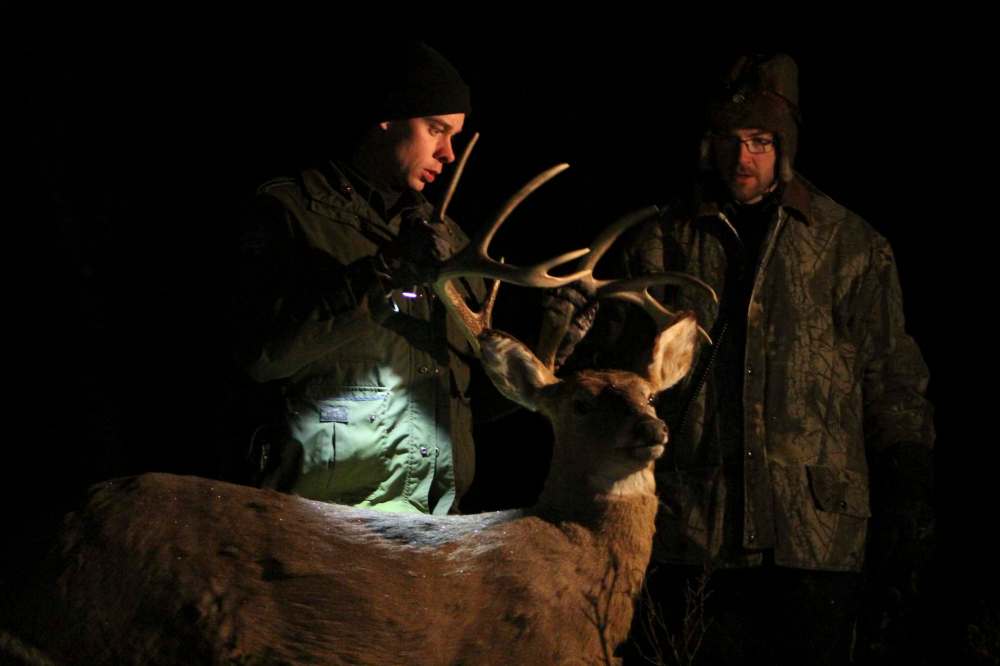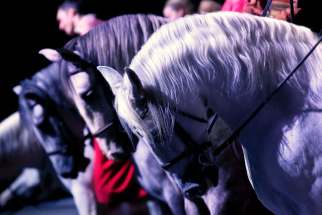Manitoba seeks to set limits on night hunting
Read this article for free:
or
Already have an account? Log in here »
To continue reading, please subscribe:
Monthly Digital Subscription
$0 for the first 4 weeks*
- Enjoy unlimited reading on winnipegfreepress.com
- Read the E-Edition, our digital replica newspaper
- Access News Break, our award-winning app
- Play interactive puzzles
*No charge for 4 weeks then price increases to the regular rate of $19.00 plus GST every four weeks. Offer available to new and qualified returning subscribers only. Cancel any time.
Monthly Digital Subscription
$4.75/week*
- Enjoy unlimited reading on winnipegfreepress.com
- Read the E-Edition, our digital replica newspaper
- Access News Break, our award-winning app
- Play interactive puzzles
*Billed as $19 plus GST every four weeks. Cancel any time.
To continue reading, please subscribe:
Add Free Press access to your Brandon Sun subscription for only an additional
$1 for the first 4 weeks*
*Your next subscription payment will increase by $1.00 and you will be charged $16.99 plus GST for four weeks. After four weeks, your payment will increase to $23.99 plus GST every four weeks.
Read unlimited articles for free today:
or
Already have an account? Log in here »
Hey there, time traveller!
This article was published 16/05/2018 (2769 days ago), so information in it may no longer be current.
Saying it is balancing public safety and Aboriginal rights, the Pallister government announced plans Wednesday to limit night hunting by Indigenous people in southern Manitoba.
Hunters would have to apply for permits to hunt in yet-to-be designated areas. Scofflaws will face a minimum $3,000 fine.
Night hunting with spotlights would still be generally allowed in the province’s north, with some restrictions near populated areas.
On Wednesday, the government led by Premier Brian Pallister introduced a bill that more clearly defines night hunting and sets out a process for discussions with Indigenous groups, rural municipalities, landowners, the Manitoba Wildlife Federation and others to determine where it will be allowed in southern agricultural areas.
FAQ
Q: What is night hunting?
A: Night hunting means to discharge a firearm at night and may include using lighting equipment that can reveal animals by reflecting the light from their eyes and can ‘freeze’ them in place… to use lighting equipment/artificial light to hunt at night.
Q: What laws cover night hunting?
A: Under the Wildlife Act, night hunting is unlawful in Manitoba except for Indigenous people, and it is illegal for anyone to hunt in a dangerous manner, including First Nation subsistence hunters. Night hunting is unlawful in Manitoba for First Nations where treaty and Aboriginal rights do not apply, such as private land without permission, provincial roadways and conservation closure areas.
Q: What is the province’s mandate pertaining to unsafe and unsustainable night hunting practices?
A: The department of Sustainable Development says it has a mandate to curtail unsustainable and unsafe hunting practices such as night hunting to keep all Manitobans safe. Anytime someone discharges a firearm at night, particularly in populated areas of the province, it poses significant risk to the safety of Manitobans. Some big-game populations are at risk of decline and overharvesting is identified as one of the factors that has an adverse effect on these populations, the province says.
Q: What is night hunting?
A: Night hunting means to discharge a firearm at night and may include using lighting equipment that can reveal animals by reflecting the light from their eyes and can ‘freeze’ them in place… to use lighting equipment/artificial light to hunt at night.
Q: What laws cover night hunting?
A: Under the Wildlife Act, night hunting is unlawful in Manitoba except for Indigenous people, and it is illegal for anyone to hunt in a dangerous manner, including First Nation subsistence hunters. Night hunting is unlawful in Manitoba for First Nations where treaty and Aboriginal rights do not apply, such as private land without permission, provincial roadways and conservation closure areas.
Q: What is the province’s mandate pertaining to unsafe and unsustainable night hunting practices?
A: The department of Sustainable Development says it has a mandate to curtail unsustainable and unsafe hunting practices such as night hunting to keep all Manitobans safe. Anytime someone discharges a firearm at night, particularly in populated areas of the province, it poses significant risk to the safety of Manitobans. Some big-game populations are at risk of decline and overharvesting is identified as one of the factors that has an adverse effect on these populations, the province says.
Q: What is Bill 29, the Wildlife Amendment Act (safe hunting and shared management)?
A: The bill sets out restrictions to night hunting in both the province’s south and north. In the south, persons exercising an Indigenous right could night hunt under a permit if they are hunting on approved public lands set out in the permit. These public lands would be determined by taking into account their use, as well as input from adjacent landowners and local governments and communities. Indigenous people would be able to exercise night hunting rights in northern Manitoba as long as they comply with restrictions in regulation that restrict night hunting near developed areas, including roads and highways.
The bill would enable the creation of shared management committees with membership from hunting and outfitting organizations, local landowners and representatives from Indigenous communities in the area that would make recommendations on measures to conserve and manage species of wildlife in specific areas.
Q: Why is the Wildlife Act being amended?
A: Many Manitobans are concerned for their well-being and safety because of an increasing number of night hunting incidents, particularly in western Manitoba. Current legislation does not adequately restrict an Indigenous right to hunt at night, the province says.
Q: What do Manitobans need to understand about the Aboriginal and treaty rights to hunt at night?
A: Treaty and Aboriginal rights relating to hunting, fishing and trapping are recognized and affirmed as part of the Constitution of Canada by Section 35 of the Constitution Act, 1982. The Natural Resources Transfer Agreement — which forms part of the Constitution Act, 1930 — provides that Indigenous people “…have the right, which the province hereby assures them, of hunting, trapping, and fishing game and fish for food at all season of the year on all unoccupied Crown lands and on any other lands to which (they) may have a right of access.” The Supreme Court of Canada, in the 2006 Morris decision, determined it is lawful for rights-based hunters to hunt at night provided it is not in a dangerous manner.
Q: How much consultation occurred before the bill was drafted?
A: The province says it supported two First Nations elders’ gatherings and engaged more than 20 First Nations communities. Letters were sent to other First Nations communities to engage in the consultation process. There were nine regional consultation sessions on night hunting with Manitoba Metis Federation.
Q: How will the permitting process and areas in southern Manitoba for hunting be defined?
A: Indigenous communities will be continuously involved in the process, the government says. Input from Indigenous communities and other stakeholders will be considered in the development of regulations related to permitting process and prescribing areas of Crown land for night hunting.
Q: What changes are proposed to compliance and enforcement practices?
A: The bill clearly defines what would constitute night hunting. This would include establishing criteria such as the use of artificial lights to search for wildlife, having ready access to firearm and having ammunition readily available. It would also establish a new minimum fine of $3,000 for people convicted of a dangerous hunting offence such as illegal night hunting.
— source: department of Sustainable Development
“I want to be clear that our priority here is the safety of all Manitobans. I believe Bill 29 strengthens public safety while respecting traditional rights,” said Sustainable Development Minister Rochelle Squires.
“We have seen deaths, serious injuries and far too many close calls as a result of unsafe night hunting practices in Manitoba.”
While rural and municipal groups praised the bill, Indigenous leaders raised concerns their hunting rights would be compromised, and some predicted the proposed legislation would be challenged in court.
The Progressive Conservatives promised to curtail what they called “unsustainable and unsafe” hunting practices, such as night hunting, during the 2016 election campaign.
In addition to a handful of deaths and several close calls in recent years, rural residents have decried cattle and farm buildings being shot, and fields being damaged, by night hunters.
Scott Phillips of Oak Lake, an RM of Sifton councillor, said there have been “dozens” of incidents involving night hunting in western Manitoba in the last 16 months alone.
“We’re just so happy that the PCs have followed through with their mandate,” he said Wednesday after the bill was introduced.
Archie McPherson, reeve of the RM of Pipestone, said the proposed legislation, once in force, will make rural communities safer. He said residents in his area have reported “lots of close calls” involving night hunting in recent years.
A new clear definition of night hunting — the possession or ready access to a firearm and ammunition and possession of an artificial light in an area where targeted animals are likely to be found — will help enforcement officers, McPherson said, adding the current wording is vague.
Designated night hunting areas in the south — e.g., in farming communities and rural municipalities — would be determined through regulation once the bill is passed.
The proposed legislation would also allow the province to create “shared management” committees to recommend ways of conserving and managing wildlife in specific areas.
Squires said the proposed legislation was prepared after extensive consultations with Indigenous communities and representatives, rural municipalities, farmers, and wildlife groups and organizations representing hunters and outfitters.
However, Indigenous leaders were not pleased.
Southern Chiefs’ Organization Grand Chief Jerry Daniels said Wednesday the province and Indigenous people could end up in court.

“We’ll likely be exploring that option. If legal action ends up being the route, that’s what it will be,” Daniels said in an interview.
He said there’s been far from sufficient consultation with the SCO, which favours having an Indigenous conservation authority.
“They’re going to pick and choose who gets permits; they’re trying to protect their sports hunters and limit our hunters,” he said.
“They haven’t even proven night hunting is less safe,” Daniels said. “Any prohibition or restriction on hunting and trapping is a direct assault on our treaty rights. They should be restricting non-Aboriginal people — they don’t have hunting rights.”
Manitoba Metis Federation president Dave Chartrand agreed the situation could go to court. “They’re leading us into a massive fight in this province.”
Assembly of Manitoba Chiefs Grand Chief Arlen Dumas told reporters consultation with Indigenous people is far from finished — it’s barely started.
“There has to be meaningful conversation,” Dumas said. “I wouldn’t call it a bill yet. It’s just a recommendation.
“There’s too much generality, things are left to interpretation. Even this notion of a ban, it’s unconstitutional, it’s unenforceable,” he said.
“The issue is not about safety. We’re consummate safe hunters,” said Dumas, who emphasized rural people know how to hunt safely and to conserve the population of animals on which their families rely for food.
Manitoba Keewatinowi Okimakanak Grand Chief Sheila North said she’s canvassing the northern chiefs about the proposed legislation.
“When First Nations made treaty with the Crown, they were guaranteed that Canada would recognize their right to hunt and fish. Given the high cost of food in grocery stores in the north, traditional source of meat are essential to the well-being of First Nation families in remote areas,” North said.
“Canada’s courts have found that Canada and its provinces cannot infringe on any First Nations’ right to secure food without meeting very strict criteria. We do not feel that Manitoba has made a strong enough case to pass legislation that would affect the treaty right to hunt and fish as our citizens and fellow southern First Nations choose.”
larry.kusch@freepress.mb.ca
nick.martin@freepress.mb.ca

Our newsroom depends on a growing audience of readers to power our journalism. If you are not a paid reader, please consider becoming a subscriber.
Our newsroom depends on its audience of readers to power our journalism. Thank you for your support.










